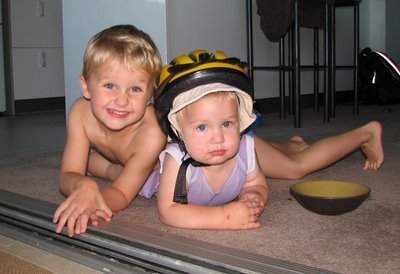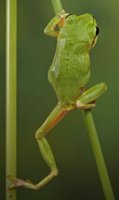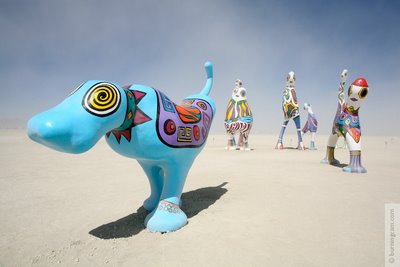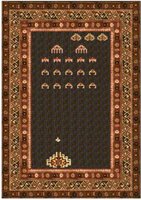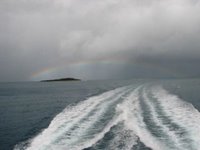Day #1: Departure
Majken and I picked-up the biggest Toyota Landcruiser we could rent. We packed our camping gear and made our way to Fraser Island. Unfortunately, we were a bit slow in packing and made a wrong turn on our way to Rainbow Beach, costing us an extra couple of hours driving time. The delay meant we missed the last barge leaving for the island. As a result we spent our first night in Rainbow.
Day #2: Waddy Point
We left early for Inskip Point where the barges depart. Before reaching Inskip we engaged the 4wd and deflated the tyres to gain better traction on the sand.
It is hard to describe the feeling of hitting the beach on Fraser from the barge - it was a mixture of pleasure and anxiety. Pleasure at the prospect of driving on the beautiful beaches, and anxiety of not knowing if the vehicle would stall or instantly get stuck in dunes.
We made our way to the northern part of the island, making excellent time driving on the hard sand of 75 Mile Beach. 75 Mile Beach is not only a fantastic beach it is also Fraser Island’s superhighway and air strip - cars (4wds) and planes share this piece of sand.
We reached our destination, Waddy Point, around noon and set up camp. We spent the rest of the afternoon on the beach. Swimming in the sea is, contrary to tradional wisdom, not a normal activity on Fraser with it's shark infested waters, but we found a little inlet where the kids could play and bath safely.
 Day #3: Champagne Pools and Indian Head
Day #3: Champagne Pools and Indian HeadIt was a fairly short drive to the Champagne Pools. Here waves from the ocean crash over the rocks, filling the rock pools with white foam giving the impression of champagne. A great place for Tobias and Christoffer to play.
Fraser Island was called K'gari by its Aboriginal inhabitants, it means paradise. The island shows evidence of Aboriginal occupation of least 5000 years, although it is possible that further archaeological work may reveal evidence of earlier occupation. Early European reports indicated that Fraser Island was heavily populated by Aboriginal people, but subsequent research suggests that there was a small permanent population of 400 - 600 which swelled seasonally to perhaps 2,000 - 3,000 in the winter months, when seafood resources were particularly abundant. The last Aborigines - Butchulla tribe - left the island in 1904 when the Aboriginal mission at Bogimbah was closed.
Leaving the Champagne Pools, we headed to Indian Head with a perfect view of the coastland. After some camera snapping including sightings of some dolphins and a Manta Ray we descended to the beach and spent the rest of the day resting and playing in the sand.
In the morning we packed our belongings and headed south on 75 Mile Beach passing a shipwreck of a luxury liner from the 1930s. It is slowly sinking into the sand. In a couple of decades it is likely be entirely submerged at the current rate of erosion.
Travelling further south we reached the entrance to Lake Wabby. The lake is a short (1.8 km) walk through the rain forest and over rolling sand dunes. The walk, however, didn't feel short in the heat and with Christoffer on my shoulders.
Wabby is a barrage lake, formed when sand blow blocks the waters of a natural spring. This phenomenon is easy to see. On one side the lake's deep green waters are bordered by a giant sand dune that is slowly moving into the water. In a century or so, the sand dune will probably have swallowed the lake. In the meantime the sand dune pushing its way into the lake provides for a speedy launch (jump) into the lake - something Tobias and Rikke did a number of times.
 Late afternoon we arrived at our campsite for the day - Central Station. Located in the middle of the rainforest it was formerly the central point for logging operations and is now a picture perfect camping ground.
Late afternoon we arrived at our campsite for the day - Central Station. Located in the middle of the rainforest it was formerly the central point for logging operations and is now a picture perfect camping ground.That night a tropical storm passed overhead. For both Christoffer and Tobias (and Rikke) it was a challenging evening with thunder and lightning and heavy ran. Christoffer in particular was upset as it was his first real experience of thunder. However, after a while he grew accustomed to the noise.
Day #5: MacKenzie and home
 For our final day on Fraser, we made our way to Lake Mackenzie, cutting through the rain forest in the rain. Mackenzie is a perched dune lake. It was formed when organic matter, such as leaves, bark and dead plants, gradually built up and hardened in depressions created by the wind. With the weather not in our favour we only spent 15 minutes admiring the crystal clear waters before heading to 75 Mile Beach for a final drive to the Barge pick-up point.
For our final day on Fraser, we made our way to Lake Mackenzie, cutting through the rain forest in the rain. Mackenzie is a perched dune lake. It was formed when organic matter, such as leaves, bark and dead plants, gradually built up and hardened in depressions created by the wind. With the weather not in our favour we only spent 15 minutes admiring the crystal clear waters before heading to 75 Mile Beach for a final drive to the Barge pick-up point.We arrived home late afternoon. Below is a picture we took of a Dingo - the only one we sighted on the island.






